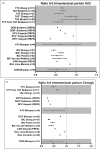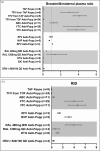Current opinion: antiretrovirals during pregnancy and breastfeeding
- PMID: 39514785
- PMCID: PMC11451929
- DOI: 10.1097/COH.0000000000000884
Current opinion: antiretrovirals during pregnancy and breastfeeding
Abstract
Purpose of review: To review the most important literature from the past 2 years on the pharmacokinetics of antiretrovirals in pregnancy, placental transfer, and breastmilk.
Recent findings: Concentrations of antiretrovirals frequently used in pregnancy and their placental transfer are described, together with infant exposure through breastmilk. Also, applications of ex-vivo and in-silico studies, such as placenta perfusion studies and PBPK models, are discussed.
Summary: Great efforts were made in the past 2 years to accelerate the availability of data on antiretrovirals during pregnancy and lactation. Bictegravir showed decreased but still sufficient concentrations during pregnancy, leading to a label change by the FDA. In-silico and clinical studies on long-acting cabotegravir and rilpivirine generated information leading to cautious use of these formulations in pregnancy. Low infant exposure to antiretrovirals through breastmilk is expected for most compounds. Despite the impact of these studies, more incentives are needed for earlier implementation, for instance, during the developmental phase of drugs, to provide women antenatally with proper information on their drugs.
Copyright © 2024 The Author(s). Published by Wolters Kluwer Health, Inc.
Conflict of interest statement
Figures
References
-
- (WHO) WHO. Mother-to-child transmission of HIV 2022. Available at: https://www.who.int/teams/global-hiv-hepatitis-and-stis-programmes/hiv/p.... [Accessed 10 April 2024].
-
- Anderson GD. Pregnancy-induced changes in pharmacokinetics: a mechanistic-based approach. ClinPharmacokinet 2005; 44:989–1008. - PubMed
-
- Koren G, Pariente G. Pregnancy-associated changes in pharmacokinetics and their clinical implications. Pharm Res 2018; 35:61. - PubMed
-
- Abduljalil K, Furness P, Johnson TN, et al. . Anatomical, physiological and metabolic changes with gestational age during normal pregnancy: a database for parameters required in physiologically based pharmacokinetic modelling. Clin Pharmacokinet 2012; 51:365–396. - PubMed
-
- Eke AC, Olagunju A, Momper J, et al. . participants of the WHO-IMPAACT workshop on “Approaches to Optimize and Accelerate Pharmacokinetic Studies in Pregnant and Lactating Women”. Optimizing pharmacology studies in pregnant and lactating women using lessons from HIV: a consensus statement. Clin Pharmacol Ther 2021; 110:36–48. - PMC - PubMed
Publication types
MeSH terms
Substances
LinkOut - more resources
Full Text Sources
Medical
Research Materials
Miscellaneous





